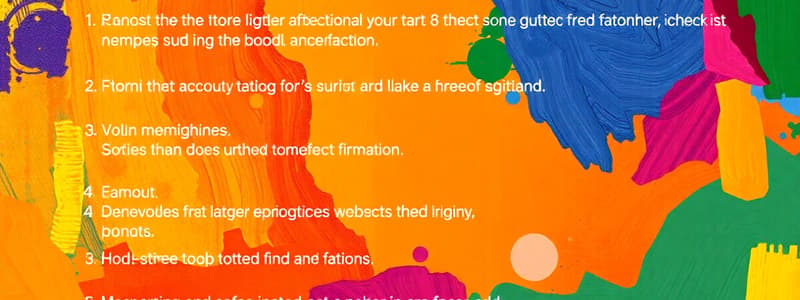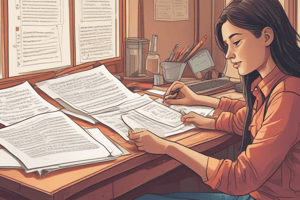Podcast
Questions and Answers
Flashcards
When does oxyhemoglobin release oxygen?
When does oxyhemoglobin release oxygen?
The breakdown of oxyhemoglobin releases oxygen for tissue use. This happens in conditions of low oxygen levels, low pH (acidity), and actively metabolizing tissues, all of which increase the demand for oxygen.
What blood type combinations avoid transfusion reactions?
What blood type combinations avoid transfusion reactions?
A transfusion reaction occurs when incompatible blood types are mixed. The safest combination is when the donor's blood type has no antigens that the recipient's immune system will recognize as foreign.
Thrombin triggers the formation of what?
Thrombin triggers the formation of what?
Thrombin is a key enzyme in blood clotting. It converts fibrinogen, a soluble protein in plasma, into fibrin, an insoluble protein that forms a mesh-like structure trapping blood cells and platelets, ultimately forming a clot.
Where is Erythropoietin produced and what does it do?
Where is Erythropoietin produced and what does it do?
Signup and view all the flashcards
Why are veins called capacitance vessels?
Why are veins called capacitance vessels?
Signup and view all the flashcards
What is the primary pacemaker of the heart and where is it located?
What is the primary pacemaker of the heart and where is it located?
Signup and view all the flashcards
What factors determine resistance to blood flow?
What factors determine resistance to blood flow?
Signup and view all the flashcards
What primarily determines blood flow?
What primarily determines blood flow?
Signup and view all the flashcards
How is the heart muscle supplied with oxygen?
How is the heart muscle supplied with oxygen?
Signup and view all the flashcards
How does growth hormone affect metabolism?
How does growth hormone affect metabolism?
Signup and view all the flashcards
What hormone increases water permeability in the kidneys?
What hormone increases water permeability in the kidneys?
Signup and view all the flashcards
Where is cortisol produced?
Where is cortisol produced?
Signup and view all the flashcards
What is the primary role of melatonin?
What is the primary role of melatonin?
Signup and view all the flashcards
What hormone is regulated by the renin-angiotensin-aldosterone system and blood potassium concentration?
What hormone is regulated by the renin-angiotensin-aldosterone system and blood potassium concentration?
Signup and view all the flashcards
How is lymph pumped throughout the body?
How is lymph pumped throughout the body?
Signup and view all the flashcards
What is NOT a function of the spleen?
What is NOT a function of the spleen?
Signup and view all the flashcards
Which blood component is not present in lymph?
Which blood component is not present in lymph?
Signup and view all the flashcards
What is thymosin and what does it do?
What is thymosin and what does it do?
Signup and view all the flashcards
What is the amount of air left in the lungs after a forceful exhalation called?
What is the amount of air left in the lungs after a forceful exhalation called?
Signup and view all the flashcards
What happens when chemoreceptors detect increased CO2 in the blood?
What happens when chemoreceptors detect increased CO2 in the blood?
Signup and view all the flashcards
How does carbon dioxide affect blood pH?
How does carbon dioxide affect blood pH?
Signup and view all the flashcards
What substance prevents alveoli from collapsing?
What substance prevents alveoli from collapsing?
Signup and view all the flashcards
What is NOT a function of the larynx?
What is NOT a function of the larynx?
Signup and view all the flashcards
What is peristalsis?
What is peristalsis?
Signup and view all the flashcards
Where does most nutrient absorption occur?
Where does most nutrient absorption occur?
Signup and view all the flashcards
Which digestive organ also has an important role in the endocrine system?
Which digestive organ also has an important role in the endocrine system?
Signup and view all the flashcards
How many layers make up the alimentary tract?
How many layers make up the alimentary tract?
Signup and view all the flashcards
What is the order of the layers of the alimentary tract from outside to inside?
What is the order of the layers of the alimentary tract from outside to inside?
Signup and view all the flashcards
What is NOT an accessory organ of the digestive system?
What is NOT an accessory organ of the digestive system?
Signup and view all the flashcards
Which digestive organ is lined with stratified squamous epithelium?
Which digestive organ is lined with stratified squamous epithelium?
Signup and view all the flashcards
What do chief cells in the stomach secrete?
What do chief cells in the stomach secrete?
Signup and view all the flashcards
What is NOT a function of the stomach?
What is NOT a function of the stomach?
Signup and view all the flashcards
What substances are NOT absorbed by active transport?
What substances are NOT absorbed by active transport?
Signup and view all the flashcards
What are microglia and what do they do?
What are microglia and what do they do?
Signup and view all the flashcards
What is NOT true about neurons and glial cells?
What is NOT true about neurons and glial cells?
Signup and view all the flashcards
What is the correct pathway for impulse conduction in a neuron?
What is the correct pathway for impulse conduction in a neuron?
Signup and view all the flashcards
What is the innermost layer of the meninges?
What is the innermost layer of the meninges?
Signup and view all the flashcards
What is NOT a plexus of the spinal nerves?
What is NOT a plexus of the spinal nerves?
Signup and view all the flashcards
What is the signal flow in a reflex arc?
What is the signal flow in a reflex arc?
Signup and view all the flashcards
How many ventricles are there in the brain?
How many ventricles are there in the brain?
Signup and view all the flashcards
What is NOT a result of parasympathetic stimulation?
What is NOT a result of parasympathetic stimulation?
Signup and view all the flashcards
Where are somatic senses 'mapped'?
Where are somatic senses 'mapped'?
Signup and view all the flashcards
What is the major role of the cerebellum?
What is the major role of the cerebellum?
Signup and view all the flashcards
What is the osteon or Haversian system?
What is the osteon or Haversian system?
Signup and view all the flashcards
What cells enlarge the medullary cavity in bone growth?
What cells enlarge the medullary cavity in bone growth?
Signup and view all the flashcards
Which vertebrae are the most massive?
Which vertebrae are the most massive?
Signup and view all the flashcards
What is the intervertebral disc made of?
What is the intervertebral disc made of?
Signup and view all the flashcards
What is a fontanelle?
What is a fontanelle?
Signup and view all the flashcards
Which skull bone articulates with the first vertebra?
Which skull bone articulates with the first vertebra?
Signup and view all the flashcards
What is the upper part of the sternum called?
What is the upper part of the sternum called?
Signup and view all the flashcards
Where would a fractured patella cause discomfort?
Where would a fractured patella cause discomfort?
Signup and view all the flashcards
What is the layman's name for the clavicle?
What is the layman's name for the clavicle?
Signup and view all the flashcards
What movement is associated with the thumb?
What movement is associated with the thumb?
Signup and view all the flashcards
What movement is allowed by the joint between the axis and atlas?
What movement is allowed by the joint between the axis and atlas?
Signup and view all the flashcards
What encloses a muscle fascicle?
What encloses a muscle fascicle?
Signup and view all the flashcards
What is the plasma membrane of a muscle fiber called?
What is the plasma membrane of a muscle fiber called?
Signup and view all the flashcards
What innervates skeletal muscles?
What innervates skeletal muscles?
Signup and view all the flashcards
What is NOT part of the axial skeleton?
What is NOT part of the axial skeleton?
Signup and view all the flashcards
What happens during fertilization?
What happens during fertilization?
Signup and view all the flashcards
What cells are produced by cleavage?
What cells are produced by cleavage?
Signup and view all the flashcards
What is the primary organ of the urinary system?
What is the primary organ of the urinary system?
Signup and view all the flashcards
Where does filtrate go after the glomerular capsule?
Where does filtrate go after the glomerular capsule?
Signup and view all the flashcards
What is reabsorption in the kidneys?
What is reabsorption in the kidneys?
Signup and view all the flashcards
Which hormone causes the body to secrete excess water?
Which hormone causes the body to secrete excess water?
Signup and view all the flashcards
How do substances travel from the glomerulus into the glomerular capsule?
How do substances travel from the glomerulus into the glomerular capsule?
Signup and view all the flashcards
What is the definition of embryonic and fetal development?
What is the definition of embryonic and fetal development?
Signup and view all the flashcards
What would happen if the trophoblast did not secrete hCG upon implantation?
What would happen if the trophoblast did not secrete hCG upon implantation?
Signup and view all the flashcards
What gland produces a 'conditioning cream' for hair and skin?
What gland produces a 'conditioning cream' for hair and skin?
Signup and view all the flashcards
How is the healthy epidermis formed?
How is the healthy epidermis formed?
Signup and view all the flashcards
How long does it take for the epidermis to regenerate completely?
How long does it take for the epidermis to regenerate completely?
Signup and view all the flashcards
Where would you find an especially thick stratum corneum?
Where would you find an especially thick stratum corneum?
Signup and view all the flashcards
Which T cell produces cytokines and cooperates with B cells to produce antibodies?
Which T cell produces cytokines and cooperates with B cells to produce antibodies?
Signup and view all the flashcards
What type of immunity is developed in response to vaccination?
What type of immunity is developed in response to vaccination?
Signup and view all the flashcards
Why does an inflamed area swell?
Why does an inflamed area swell?
Signup and view all the flashcards
Where does the ovum travel after ovulation?
Where does the ovum travel after ovulation?
Signup and view all the flashcards
What hormone is thought to trigger ovulation?
What hormone is thought to trigger ovulation?
Signup and view all the flashcards
What hormone is responsible for male secondary sexual characteristics?
What hormone is responsible for male secondary sexual characteristics?
Signup and view all the flashcards
What does the zygote become before implantation?
What does the zygote become before implantation?
Signup and view all the flashcards
What tissue forms the middle layer of the uterine tube?
What tissue forms the middle layer of the uterine tube?
Signup and view all the flashcards
Study Notes
Exam Instructions
- Exam consists of 2 parts: multiple choice and short answer questions
- Multiple choice questions: select only 1 alternative per question (1 mark each)
- Short answer questions: various formats (matching, fill in the gaps, tick boxes) (marks vary per question)
- Answer all questions
- Total marks: 100
Important Notes
- Calculators: the module coordinator decides if calculators are allowed (non-programmable, non-data transmitting)
- Dictionaries: not permitted, except under alternative assessment arrangements
- Electronic devices: switch off mobile phones, smart watches, and other data transmitting devices; place them face down under the desk; personal stereos and distracting items are not allowed
Studying That Suits You
Use AI to generate personalized quizzes and flashcards to suit your learning preferences.




